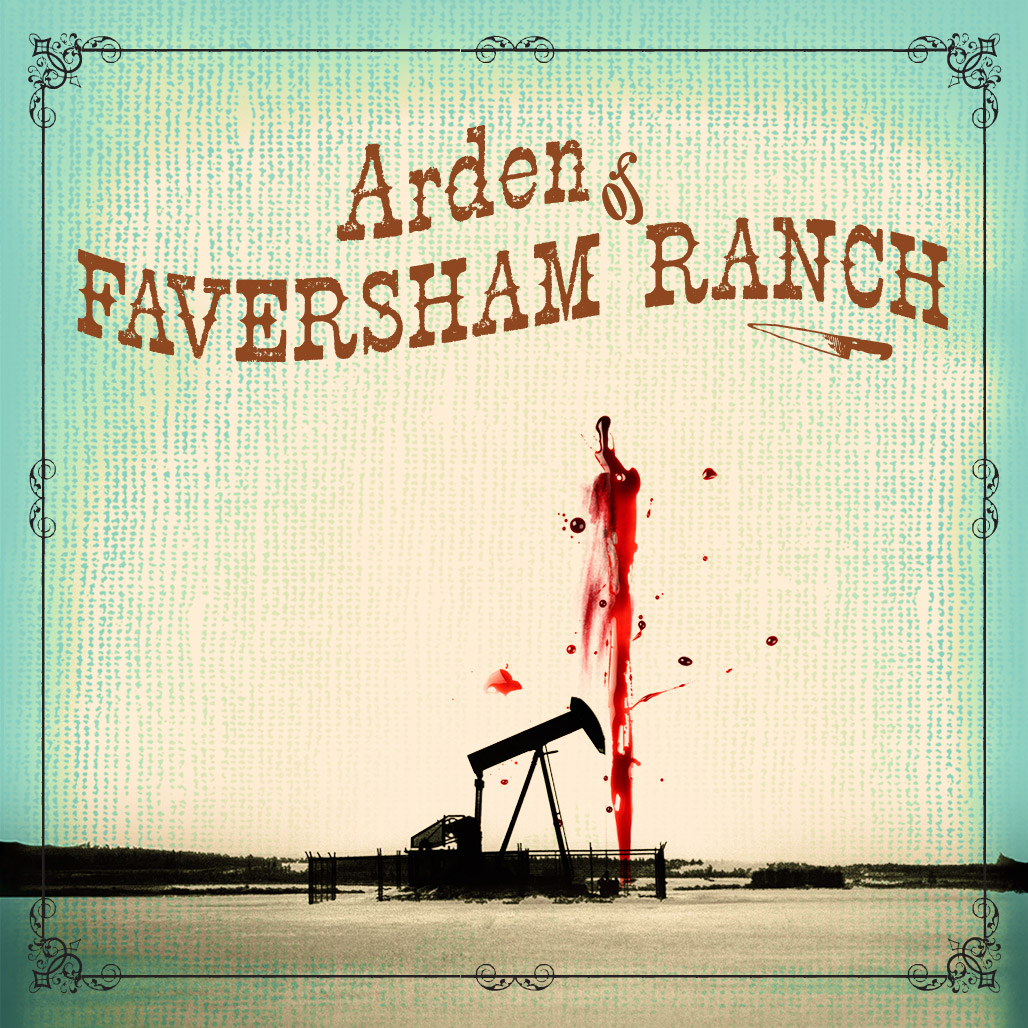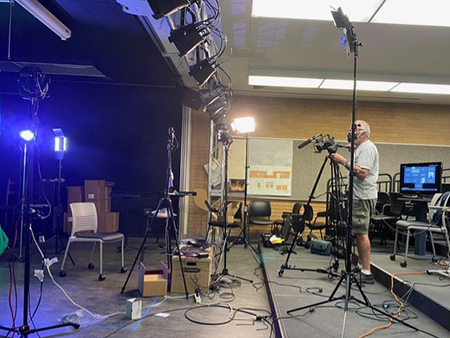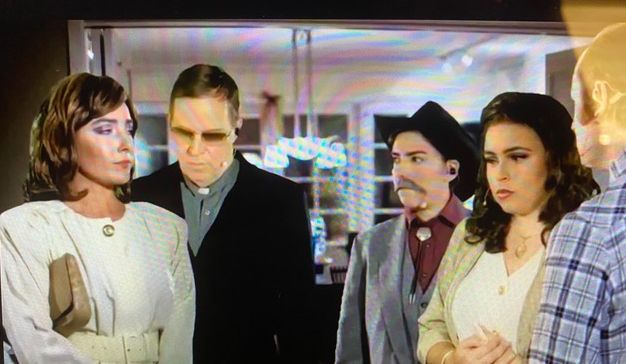
COM’s Drama program was having its final run-throughs for The Tempest when director, Dr. Lisa Morse, found out College administrators were going to close campus facilities.
“It was really hard to do,” recalls Morse, who is also a professor and Chair of the Drama program. “But it was the smart thing to do, obviously, especially seeing now how challenging it is to contain this virus. We were one among many in the community who did the right thing. We just had to transition to online learning and finish out the semester. And that was a huge undertaking.”
She and Ron Krempetz, set designer and technical theatre instructor at COM, were brainstorming ways they could create a constructive production for their students while taking a summer course in online teaching to prepare for this fall. Krempetz had started creating a radio booth set design for the upcoming fall play so each actor would have their own booth. Partway through, they were told they wouldn’t be able to have students on campus to do this. Then, a long-time friend of the Dance and Drama programs, Ernie Ernstrom, suggested using a software program that would enable actors to act with a camera remotely and separately in front of a green screen. The software program would combine the images in real time to make it look like they were acting together.
It sounded perfect, but they knew they had so much to learn in order to teach their students how to act and work with this new technique.
 By then, Morse already knew the play she wanted to direct called Arden of Faversham. From the sixteenth century and based on a true story, it tells the tale of an unhappy wife who takes a lover and together they plot to kill her inattentive husband. It was written anonymously, but many think Thomas Kyd, Shakespeare, and possibly Marlowe wrote scenes for it. Now, it’s “completely changed and revised by this devilish woman here,” Morse quips.
By then, Morse already knew the play she wanted to direct called Arden of Faversham. From the sixteenth century and based on a true story, it tells the tale of an unhappy wife who takes a lover and together they plot to kill her inattentive husband. It was written anonymously, but many think Thomas Kyd, Shakespeare, and possibly Marlowe wrote scenes for it. Now, it’s “completely changed and revised by this devilish woman here,” Morse quips.
As Morse reworked the script over summer, it’s melodramatic, soap-opera tone made her think she should set the play in the 1980’s “because there is a really interesting parallel with the crises we were going through at that time,” observes Morse. “This kind of ultra-conservatism and conservative point of view. It was a period of a lot of selfish entrepreneurs which is what you see in Arden himself. There seemed to be a lot of really significant parallels. Then, of course, I remembered the TV show Dallas. I couldn’t help but see JR Ewing and all the female characters from Dallas in there. So, I thought, ‘okay, how do I make this work?’”
Morse found the perfect location for the play in Beaumont, Texas. It had the needed characteristics, such as access to water and close to a large city, Galveston. She changed the name of the play to Arden of Faversham Ranch and rewrote the script to fit the time period and location.
Krempetz and Morse have decades of experience teaching stage production and acting. Yet, this was something they and the rest of the production staff were just starting to grasp how to translate it to the virtual environment when fall semester started. “This is technology with a booster shot. I would learn something on a Monday and teach it to my classes on Tuesdays and Wednesdays,” remembers Krempetz. “I was honest with them saying, ‘I am only one step ahead of you. Let’s go on the internet and find out what are all these different things we are going to be using remotely.’ I was looking at their faces on the screen and I would say, ‘that’s the exact same look I had when they were explaining it to me! Let’s go slowly with this.’”
They were all learning how to create this new production using sophisticated software called Mimo Live. It enables actors to look like they are together in front of a scenic picture even though the actors are in separate locations. The software stacks their images, one in front of the other and adjustments are made to the actors’ height and proportions to make it look like everyone is in one place. Each actor’s camera, lighting, and sound are connected a laptop that is controlled remotely by production crew members from their homes – one is even in Cincinnati, Ohio. Each take is recorded to be edited later into the final production.
 Each actor is given a production packet that includes a laptop, three lights, a green screen, an iPhone leased to the College by Verizon, and a headset. The headset has a microphone and an earpiece enabling them to communicate in real time with the other actors. Often, actors act to a dot or crease in a wall in order to make it look like they are talking with the other person. Everything has to be considered in order to make it look like they are together, such as an actor’s height, their movement, if it is a closeup or wide-angle camera shot, and many other details.
Each actor is given a production packet that includes a laptop, three lights, a green screen, an iPhone leased to the College by Verizon, and a headset. The headset has a microphone and an earpiece enabling them to communicate in real time with the other actors. Often, actors act to a dot or crease in a wall in order to make it look like they are talking with the other person. Everything has to be considered in order to make it look like they are together, such as an actor’s height, their movement, if it is a closeup or wide-angle camera shot, and many other details.
There are thirteen actors acting seventeen parts with only ten production packets. This means there are times the packets need to be dropped off, cleaned, and then sit for three days before going to the next actor.
In order to get the scene images, Krempetz used his licenses from photography sites to gather some of them. He even found a drone shot of a ranch to use for a scenic segue shot. For Faversham Ranch interior shots, a COM alumnus, Stephanie Ahlberg and her husband, kindly let them use her home to take pictures of the different locations.
Morse and Krempetz worked with professional photographer (and former Drama program administrative assistant), Robin Jackson, to take multiple pictures of the different locations within Ahlberg’s house. First, a picture was taken of the location, for example, the dining room. Next Morse or Krempetz would stand in as a model to get the right perspective of how big a person is in that room for that shot. Using their spreadsheet shot list, they had to take multiple pictures of a location from all the angles needed for each actor’s perspective, keeping in mind their height, movement, if a closeup or wider angle was needed, as well as if it should be in focus or not.
This spreadsheet is the master document they use each night they shoot scenes. It contains 536 pictures, and each picture has a description of what’s happening in the scene. It’s extremely detailed—who’s in each shot, what the point of view is (i.e. a closeup, mid-shot, wide-shot, etc.), what are the costumes, the props, the lighting cues, how many takes there are, and so forth. Because they don’t shoot scenes in order of the play, this document is essential in to keeping everything organized. “It’s been a massive undertaking,” explains Morse.
By the time the production wraps up, every actor will have invaluable film and television experience, learning about working in front of a green screen, framing, angles, focal points, and so much more.

Editing this to create the final production is a detailed process. It’s not only assessing which shot to use for each cut, but adding sound effects and equalizing the sound of the dialogue since each actor’s surroundings creates a different background noise.
Once completed, the show will be free to watch, with donations accepted to help support the program and the entire season’s four shows during this time. Typically, one-quarter of their budget comes from ticket sales, and with no sales this year, next year’s season will start in a deficit.
They hope to release Arden of Faversham Ranch right around Thanksgiving. “I love having shows happen on Thanksgiving weekend,” adds Morse, “because everyone is always looking for something to do. I think this show is the perfect cult-following show. Content-wise, style-wise it’s so different from anything else. It’s the perfect thing to sit down to after Thanksgiving to have a good laugh.”
Both Morse and Krempetz acknowledge this production would not have been possible without the creative vision and practical know-how of Ernie Ernstrom; the technical skills of designers Walter Holden, Pamela Johnson, Margie Finney, Jeffrey Brown, Noah Brown, Billie Cox, David White, Eric White; Stage Managers Jack Kelly and Michael Kessell; and Combat Director Richard Squeri. It took a village to make this happen!
Stay tuned for details regarding the virtual performance. pa.marin.edu
